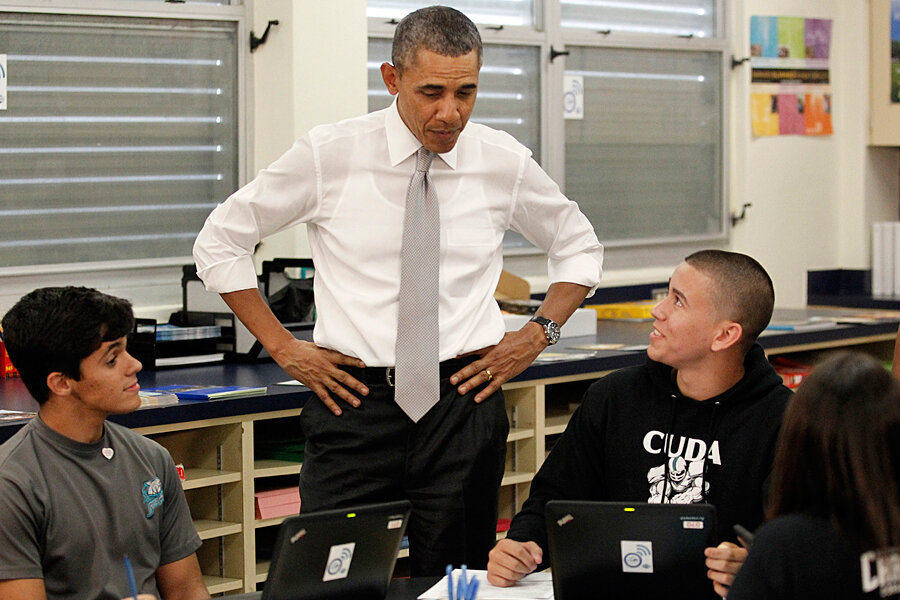Obama, touting a college education, urges seniors: fill out financial aid form
Loading...
President Obama visited a school in Miami Friday to announce steps to boost the number of high school seniors who apply for college grants and loans.
The FAFSA Completion Initiative, referring to the Free Application for Federal Student Aid, includes new resources to help states and high schools support students who don’t know how to complete the form – or perhaps aren’t even aware it exists.
It’s an important piece of Mr. Obama’s broader push to increase college access and success. For low- and middle-income students, studies have suggested that the chances of enrolling in college are 25 to 30 percent higher if they complete the FAFSA. Yet some researchers have estimated that only about 57 percent of high school seniors do so.
In Florida, where 55 percent of seniors filled out FAFSAs, those who didn’t collectively missed out on about $100 million in federal Pell Grants, not to mention state aid that requires the FAFSA to determine eligibility, reports Florida College Access Network.
“Nationwide, over 1 million high school students do not fill out the FAFSA,” Obama said. “My challenge to every high school student in America: Fill out the form. Even if you think you might not qualify for financial aid, fill out the form.... We’re making it easier than ever ... and it could change the rest of your life.”
Raising awareness about the importance of the FAFSA and giving students easy ways to complete it are key to Obama’s college-completion agenda.
“It is low-hanging fruit. We need to get more students into college with financial aid packages that allow them to complete college,” says Clare McCann, a policy analyst at the nonprofit think tank New America, in Washington.
Some high-schoolers simply don’t know about the FAFSA. They may have parents who didn’t attend college and don’t understand the process. They may think they can afford only the local community college, if that. They may not be exposed to the FAFSA by overburdened school counselors.
The two states with the lowest FAFSA completion rates, Utah and Arizona, have particularly high caseloads for counselors – 726 and 861 students per counselor, New America reports.
Even if students know about the FAFSA, “those that are most likely to be eligible [for financial aid] are the least likely to think that they are,” says Lauren Asher, president of the Institute for College Access & Success, in Oakland, Calif.
Others may start filling out the form and have trouble understanding how to answer questions about everything from taxes to family assets. It can feel “so onerous that the time investment doesn’t seem worth the reward,” Ms. McCann says.
Still others may think they’ve completed the form, and tell their counselors so, but in actuality they may have missed some key components. Florida researchers found that in a single year, 5,600 FAFSAs filled out by 12th-graders in the state had a crucial error.
That’s one reason Obama’s initiative is expanding the ways that schools and states can verify with the Department of Education whether students have completed the forms. Since 2010, the department has piloted the idea in about 100 school districts, including Miami-Dade.
At Coral Reef High School in Miami – where the president spoke Friday, accompanied by Michelle Obama – less than half the seniors completed the FAFSA four years ago. But last year, after concerted efforts, 71 percent did, The Miami Herald reports.
Often local advocacy groups can help educate students about the FAFSA. In Florida, a group called Champions for Learning piloted a program at a high school and boosted FAFSA completion rates by 7 percent.
The Department of Education’s FAFSA completion data tool is being expanded to include more than 25,000 high schools nationwide. Anyone can access it at StudentAid.gov/fafsa-hs-data to see overall rates for various high schools. And governors will now be able to tell school administrators which students have not completed the FAFSA.
Already, the Obama administration has simplified the FAFSA and allowed people to import IRS data into the form online. On average, it now takes people less than 25 minutes to fill it out. The White House says that’s one reason the number of forms filed grew by 33 percent between 2009 and 2013. It’s not clear how much of that growth is among high-schoolers who previously would not have applied.
Simplifying the process was “a huge step forward,” but more reforms are needed, Ms. Asher says. For those whose incomes are too low to necessitate the filing of a 1040 tax return, it should be an option to import W-2 information into the FAFSA, she says. And if students could find out their eligibility for aid earlier than the spring of senior year, by using the previous year’s tax data, she says, more of them would realize they should apply for college.








